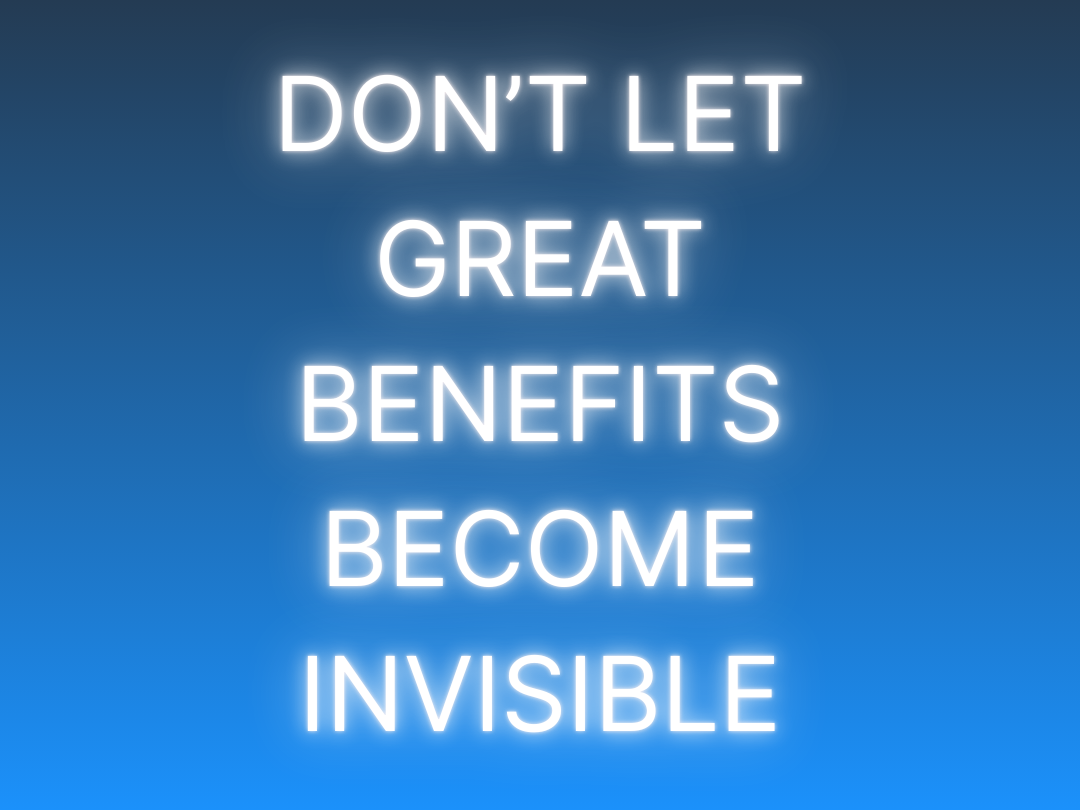Mastering HR Communication: Tailoring Employee Benefits Across Generational Groups
Hey there, HR leaders!
In this post we’re going to dive into a crucial aspect of human resources: effectively communicating the value of employee benefits to diverse generational groups. As the workplace continues to evolve, so do the expectations and preferences of employees from different age brackets. Understanding these nuances and crafting tailored communication strategies can significantly enhance employee satisfaction and retention rates.
Let's break it down:
1. Know Your Audience:
Each generation—Baby Boomers, Generation X, Millennials, and Gen Z—has distinct characteristics and priorities. Baby Boomers may prioritize retirement plans and healthcare benefits, while Millennials and Gen Z might value flexibility, professional development opportunities, and wellness programs. Tailor your communication to resonate with the specific needs and preferences of each group.
Baby Boomers (Born 1946-1964):
- Priorities: Retirement security, healthcare benefits, work-life balance.
- Data and Metrics:some text
- According to a study by the Transamerica Center for Retirement Studies, 56% of Baby Boomers plan to continue working past age 65, highlighting the importance of retirement planning benefits.
- A survey by AARP found that 74% of Baby Boomers consider healthcare benefits a crucial factor in their job satisfaction.
- Engagement Tip: Recognize their years of experience and dedication to their careers. Offer retirement planning seminars and emphasize the stability of your company's pension plans.
Generation X (Born 1965-1980):
- Priorities: Work-life balance, career advancement opportunities, financial stability.
- Data and Metrics:some text
- Research by MetLife indicates that 79% of Generation X employees value workplace flexibility, emphasizing the importance of flexible work arrangements and family-friendly policies.
- A survey by LinkedIn found that 94% of Generation X professionals are open to hearing about job opportunities, underscoring the significance of career development and advancement programs.
- Engagement Tip: Acknowledge their desire for work-life balance and career advancement. Provide flexible work schedules and opportunities for professional development, such as mentorship programs or leadership training.
Millennials (Born 1981-1996):
- Priorities: Flexibility, professional development, purpose-driven work.
- Data and Metrics:some text
- Gallup reports that 60% of Millennials are open to job hopping, emphasizing the need for employers to offer compelling benefits and growth opportunities to retain top talent.
- According to the Society for Human Resource Management (SHRM), 93% of Millennials prioritize ongoing skills development, highlighting the value of robust professional development programs.
- Engagement Tip: Understand their preference for purpose-driven work and continuous learning. Offer benefits like volunteer time off and tuition reimbursement programs to support their personal and professional growth.
Gen Z (Born 1997-2012):
- Priorities: Work-life balance, career progression, technology-driven solutions.
- Data and Metrics:some text
- A survey by Deloitte found that 38% of Gen Z respondents prioritize work-life balance over career advancement, signaling the importance of flexible work arrangements and well-being initiatives.
- Research by Monster reveals that 58% of Gen Z employees prefer digital communication channels for workplace communication, emphasizing the need for HR to leverage technology in benefit communication efforts like employee benefits websites (see SwellSpace).
- Engagement Tip: Cater to their tech-savvy nature and desire for career progression. Implement digital communication tools for easy access to benefits information and provide opportunities for early career development through internships or apprenticeships.
2. Speak Their Language:
Effective communication hinges on speaking the language of your audience. Baby Boomers may prefer face-to-face meetings or traditional communication channels like newsletters, whereas Millennials and Gen Z tend to gravitate towards digital platforms such as email, social media, and websites/apps. Consider utilizing a mix of communication channels to reach different generational groups effectively.
Baby Boomers:
- Utilize in-person meetings and printed materials to communicate benefit options clearly and comprehensively. Provide one-on-one sessions with HR representatives to address any questions or concerns.
Generation X:
- Utilize a combination of email, video conferencing, and online portals/websites to deliver benefit information in a convenient and accessible manner. Offer webinars or virtual town hall meetings to discuss benefit updates and changes.
Millennials:
- Leverage social media platforms and public-facing benefits websites to engage with Millennials and share information about available benefits. Create interactive content such as infographics or videos to make complex benefit information easier to understand.
Gen Z:
- Embrace emerging communication channels such as video messaging to engage with Gen Z employees. Provide quick access to benefits information through mobile-optimized websites and utilize gamification techniques to make learning about benefits fun and engaging.
3. Highlight Personalization and Choice:
Offer a range of benefits that cater to the diverse needs of your workforce. From flexible work arrangements and wellness initiatives to professional development programs and financial planning assistance, providing options empowers employees to select benefits that align with their individual lifestyles and priorities.
Baby Boomers:
- Offer personalized retirement planning services and healthcare options tailored to individual needs. Provide a variety of retirement savings plans and healthcare coverage options to accommodate different preferences.
Generation X:
- Allow flexibility in work hours and locations to support their work-life balance. Offer a menu of benefits, including wellness programs, financial planning services, and career development opportunities to cater to diverse needs.
Millennials:
- Provide customizable benefits packages that allow Millennials to select options that align with their lifestyle and values. Offer benefits such as student loan repayment assistance or remote work options to address their unique financial and work preferences.
Gen Z:
- Offer flexible work arrangements and technology-driven solutions that empower Gen Z employees to work in ways that suit their individual preferences. Provide opportunities for skill development and career growth through online learning platforms and mentorship programs.
4. Emphasize the Long-Term Value:
Communicate the long-term value of employee benefits beyond immediate gratification. Highlight how benefits like retirement plans and health savings accounts contribute to financial security and overall well-being over time. Demonstrating the tangible impact of these benefits can foster greater appreciation and engagement across generational groups.
Baby Boomers:
- Illustrate the long-term benefits of retirement plans and healthcare coverage in ensuring financial security and well-being during retirement years. Provide resources and tools to help Baby Boomers plan for their future.
Generation X:
- Communicate how investing in professional development and financial planning now can lead to greater career advancement and financial stability in the future. Offer incentives such as employer-matched retirement contributions to encourage long-term saving.
Millennials:
- Highlight how benefits such as student loan repayment assistance and retirement savings plans can alleviate financial stress and set Millennials up for success in the long run. Provide access to financial wellness resources to support their financial goals.
Gen Z:
- Demonstrate the value of early career development and skill-building opportunities in shaping a successful and fulfilling career trajectory. Offer benefits such as tuition reimbursement and career coaching to help Gen Z employees invest in their future.
5. Utilize Storytelling:
Harness the power of storytelling to humanize your communication efforts. Share real-life examples and testimonials from employees who have benefited from specific programs or initiatives. Personal anecdotes resonate deeply and can help bridge the gap between different generational perspectives, fostering empathy and understanding.
Baby Boomers:
- Share success stories of Baby Boomers who have successfully transitioned into retirement and are enjoying the benefits of their retirement plans. Highlight how healthcare benefits have provided peace of mind during critical times.
Generation X:
- Feature testimonials from Generation X employees who have benefited from flexible work arrangements and career development opportunities. Share stories of individuals who have achieved work-life balance while advancing their careers.
Millennials:
- Showcase stories of Millennials who have utilized professional development programs to advance their careers and make meaningful contributions to the company. Highlight how benefits like parental leave and wellness programs have supported their well-being.
Gen Z:
- Share experiences of Gen Z employees who have leveraged technology-driven solutions and early career development opportunities to kickstart their careers. Illustrate how benefits such as remote work and digital learning platforms have empowered them to thrive in the workplace.
6. Encourage Feedback and Adaptation:
Foster a culture of open communication and feedback to continuously refine your benefits offerings. Solicit input from employees across different age groups to understand their evolving needs and preferences. By staying agile and responsive, you can ensure that your benefits package remains relevant and impactful across generations.
Baby Boomers:
- Seek input from Baby Boomers through focus groups or surveys to understand their evolving needs and preferences. Use their feedback to refine benefit offerings and communication strategies.
Generation X:
- Engage Generation X employees in discussions about work-life balance and career development opportunities. Implement changes based on their feedback to better support their needs.
Millennials:
- Foster a culture of open communication where Millennials feel comfortable sharing their thoughts and ideas about benefits and workplace policies. Actively seek their input to ensure that benefits remain relevant and impactful.
Gen Z:
- Create asynchronous channels for Gen Z employees to provide feedback on benefit offerings and communication methods. Incorporate their suggestions into future initiatives to better meet their needs and expectations.
By applying these strategies tailored to each generational group, HR leaders can effectively communicate the value of employee benefits and foster greater engagement and satisfaction across the workforce. Remember, understanding and catering to the unique preferences and priorities of each generation is key to building a thriving and inclusive workplace culture.
Cheers to mastering HR communication across generations!
.webp)




